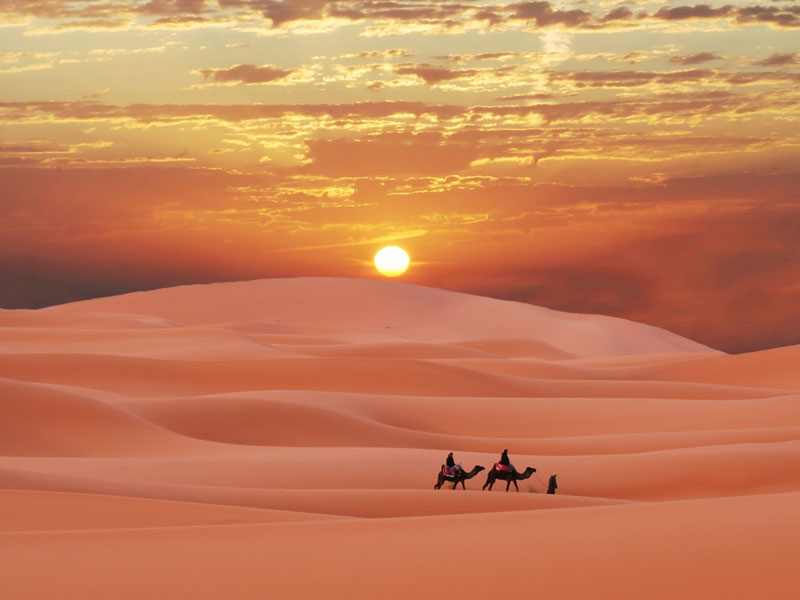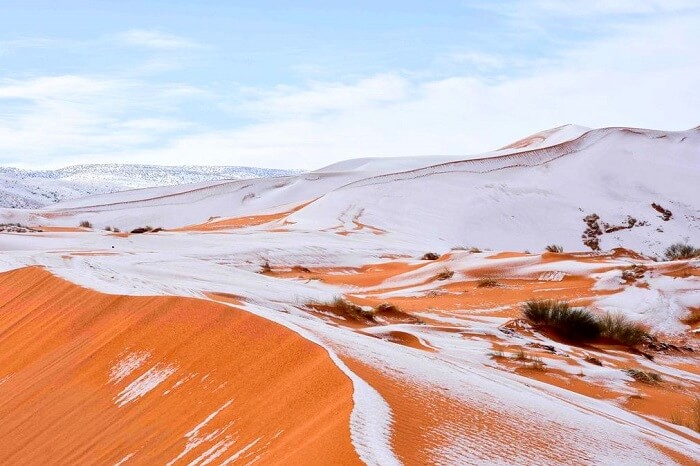Sahara Desert
Sahara Desert:
The Sahara ( Arabic: الصحراء الكبرى, aṣ-ṣaḥrāʼ al-kubrá, 'the Great Desert') is a desert located on the African continent. It is the largest hot desert in the world, and the third largest desert overall after Antarctica and the Arctic. Its area of 9,200,000 square kilometres (3,600,000 sq mi)is comparable to the area of China or the United States. The name 'Sahara' is derived from a dialectal Arabic word for "desert", ṣaḥra (صحرا/).
The desert comprises much of North Africe, excluding the fertile region on the Mediterranean Sea coast, the Atlas Mountains of the Maghreb, and the Nile Valley in Egypt and Sudan. It stretches from the Red Sea in the east and the Mediterranean in the north to the Atlantic Ocean in the west, where the landscape gradually changes from desert to coastal plains. To the south, it is bounded by the l Sahel, a belt of sami-arid tropical savanna around the Niger River valley and the Sudan Region of Sub-Saharan Africa The Sahara can be divided into several regions including: the western Sahara, the central Ahaggar Mountains , the Tibesti Mountains, the Air Mountains, the Tenere desert, and the Libyan Desert.
For several hundred thousand years, the Sahara has alternated between desert and savanna grassland in a 41,000 year cycle caused by the precession of the Earth's axis as it rotates around the Sun, which changes the location of the North African Monsoon . The area is next expected to become green in about 15,000 years (17,000 AD). There is a suggestion that the last time that the Sahara was converted from savanna to desert it was partially due to overgrrazing by the cattle of the local population.

Climate:
The Sahara is the world's largest low-latitude hot desert . It is located in the horse latitudes under the subtropical ridge, a significant belt of semi-permanent subtropical warm-core high pressure where the air from upper levels of the troposphere tends to sink towards the ground. This steady descending airflow causes a warming and a drying effect in the upper troposphere. The sinking air prevents evaporating water from rising, and therefore prevents adiabatic cooling, which makes cloud formation extremely difficult to nearly impossible.
The permanent dissolution of clouds allows unhindered light and thermal radiation. The stability of the atmosphere above the desert prevents any convective overturning, thus making rainfall virtually non-existent. As a consequence, the weather tends to be sunny, dry and stable with a minimal chance of rainfall. Subsiding, diverging, dry air masses associated with subtropical high-pressure systems are extremely unfavorable for the development of convectional showers. The subtropical ridge is the predominant factor that explains the hot desert climate of this vast region. The descending airflow is the strongest and the most effective over the eastern part of the Great Desert, in the Libyan Desert: this is the sunniest, driest and the most nearly "rainless" place on the planet, rivaling the Atacama Desert, lying in Chile and Peru.
The rainfall inhibition and the dissipation of cloud cover are most accentuated over the eastern section of the Sahara rather than the western. The prevailing air mass lying above the Sahara is the continental tropical (CT) air mass, which is hot and dry. Hot, dry air masses primarily form over the North-African desert from the heating of the vast continental land area, and it affects the whole desert during most of the year. Because of this extreme heating process, a thermal low is usually noticed near the surface, and is the strongest and the most developed during the summertime. The Sahara High represents the eastern continental extension of the Azores High centered over the North Atlentic Ocean. The subsidence of the Sahara High nearly reaches the ground during the coolest part of the year, while it is confined to the upper troposphere during the hottest periods.
The effects of local surface low pressure are extremely limited because upper-level subsidence still continues to block any form of air ascent. Also, to be protected against rain-bearing weather systems by the atmospheric circulation itself, the desert is made even drier by its geographical configuration and location. Indeed, the extreme aridity of the Sahara is not only explained by the subtropical high pressure: the Atlas Mountains of Algeria, Morocco and Tunisia also help to enhance the aridity of the northern part of the desert. These major mountain ranges act as a barrier, causing a strong rain shadow effect on the leeward side by dropping much of the humidity brought by atmospheric disturbances along the polar front which affects the surrounding Mediterranean climates.
The primary source of rain in the Sahara is the Intertropical Convergence Zone, a continuous belt of low-pressure systems near the equator which bring the brief, short and irregular rainy season to the Sahel and southern Sahara. Rainfall in this giant desert has to overcome the physical and atmospheric barriers that normally prevent the production of precipitation. The harsh climate of the Sahara is characterized by: extremely low, unreliable, highly erratic rainfall; extremely high sunshine duration values; high temperatures year-round; negligible rates of relative humidity; a significant diuenal temperature variation; and extremely high levels of potential evaporation which are the highest recorded worldwide.

SnowFall in Sahara Desert


Nice blog! Thank you! Have a good day!
ReplyDeleteSaleem